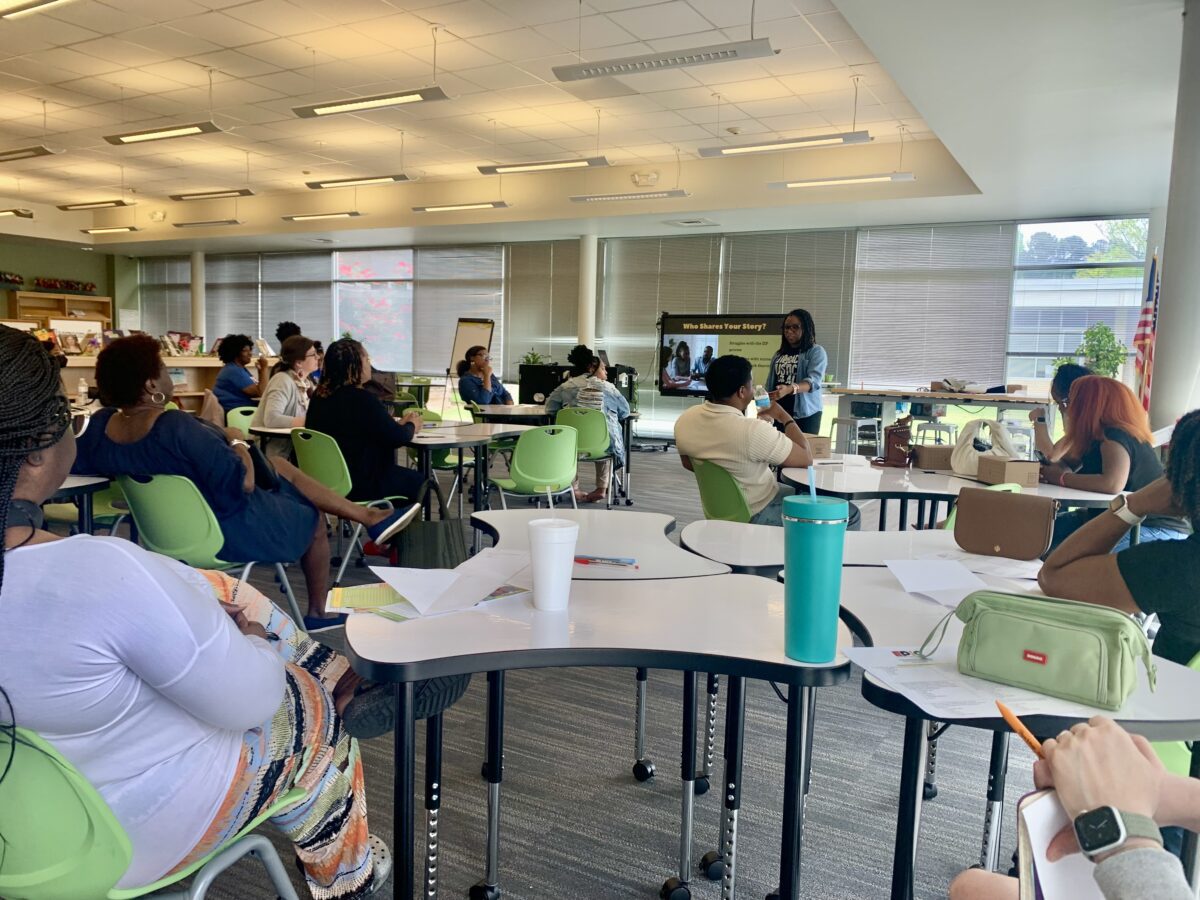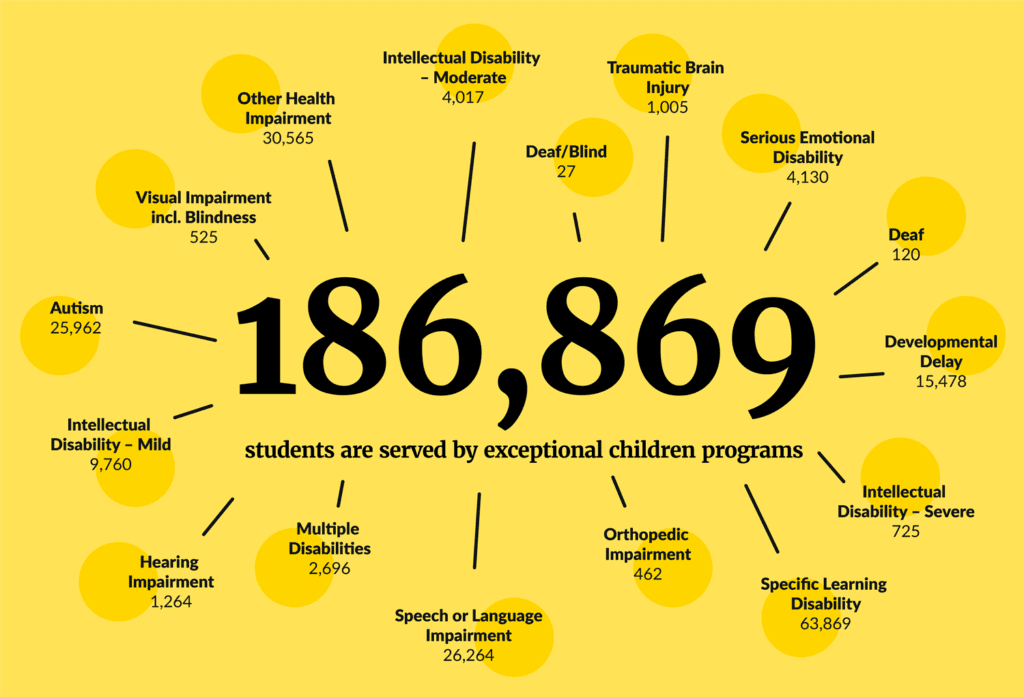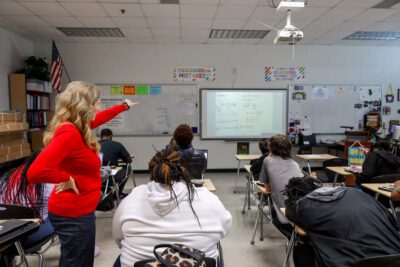
|
|
Many special education teachers in North Carolina believe the pipeline into the classroom is stressed, according to a new survey and analysis from EdNC. Survey respondents mentioned pay, resources to recruit candidates, and the daily needs and demands of teachers as factors negatively impacting the educator pipeline.
From April 2 to April 19, EdNC conducted a survey of North Carolina educators that work in Exceptional Children (EC) departments, which serve and facilitate curriculum for students with learning differences.
Out of 237 survey respondents, 17% work at charter schools and 83% work at traditional public schools. The survey included respondents from 50 county districts and one city-school district.
Respondents answered eight open-ended questions about the teacher pipeline and how resources impacted the work conditions of new teachers and their professional development. Many answers emphasized the urgency of supporting beginning teachers to meet the increasing needs of students in their districts.
“There are more intensive student needs across all classrooms, special education and general education,” Carmen Boros, an occupational therapist, said in the survey. “Many teachers and instructional assistants don’t have the skills to deal with behaviors and other needs. Staff frequently quits when they find higher paying, less stressful jobs.”
The special education teacher pipeline
About 75% of teachers surveyed believe that the pipeline for special education is stressed, according to the EdNC survey results.
The teacher pipeline refers to the process of recruiting students to become teachers, developing their skills, and keeping them as educators through retirement.
Four-year colleges and universities are the most common pathway for educator preparation programs (EPP). However, enrollment in North Carolina EPPs fell 9% over the past ten years, peaking in 2021, according to a dashboard from the Department of Public Instruction (DPI).
Prospective exceptional children teachers in North Carolina must hold at least a bachelor’s degree. For those entering teaching right after college, their educator preparation program must be at an accredited school. Once they pass a standardized exam in their preferred subject area — which includes EC — they can apply for a teaching license to begin teaching in North Carolina. Special education licensure requires a foundation of reading and a math subtest in addition to the standardized exam.
Teachers who have already entered the classroom usually have to cover the additional cost of getting licensed in another subject area if they want to switch subject areas.
Teacher turnover increased in North Carolina last school year, with 11.5% of all teachers leaving their role last school year, up from 7.8% the year before.
While the state is still hiring more teachers than the number who left, turnover was highest among beginning and special education teachers. Roughly 20% of the state’s teacher vacancies were for K-12 EC teachers, according to DPI’s State of the Teaching Profession report.
Sonja Emerson, an EC director, said in her survey response that there will soon be fewer experienced teachers to mentor incoming graduates from teacher preparation programs.
“Institutions of higher education are not graduating Exceptional Children teachers at the significant rate that is required to maintain an adequate workforce for our most vulnerable students,” Emerson said. “Teachers who seek this career through other licensing options within our state (residency, emergency, limited, etc.) are often overwhelmed with the demands of teaching students with disabilities, as well as the level of required paperwork and compliance aligned with state and federal laws.”
When asked to elaborate on what makes the EC teacher pipeline stressed, more than one quarter of survey respondents said that classroom demands, paperwork, and general workload account for why teachers are leaving.
Teachers who remain are given more responsibilities to fulfill student needs. This, some survey respondents said, leads to burn out.
Cindy Dotson said that limited school funding causes their teachers to have higher caseloads.
“Most of our students are on the regular education continuum,” Dotson said in the survey response. “With the proposed allocation of funds, our resources will be reduced and will lead to larger caseloads, thus reducing the quality of support a disabled student needs to close the gap between their performance and grade level expectations.”
When teachers were asked to describe how healthy or stressed their EC teacher pipeline is, the most common factor respondents cited was the workload or caseload of teachers. Respondents said teachers can be overwhelmed by the number of students that they serve to collect data.
When asked what districts do to recruit and retain EC teachers, the survey yielded mixed results.
“As part-time employees, we receive very few benefits and no job security beyond the current school year,” said Brooks Jones.
One in four teachers said their district recruited teachers through online job postings. Other common tactics included job fairs and promotions at colleges and universities.
Half of respondents said they did not know or did not believe their district had an active plan to encourage their EC teachers to stay in the district. Respondents who did see retention efforts in their districts pointed to support from administrators and other school leaders as a key factor.
“My principal is good about getting the tools that we need to teach in each of the EC classrooms,” said Rasheeda Ruffin. “She has an open-door policy where we can discuss what is working and what is not.”
Need for more resources
Every district has a unique variety of needs. Through our survey, EdNC pinpointed a few common factors impacting EC teachers and classrooms.
Geography, funding, and an overall shortage of resources in a community were factors that respondents said affected them inside the classroom, along with high caseloads.
North Carolina schools receive funding from three different sources — federal, state, and local funding. The share from each source varies from district to district. Local funding varies widely across the state, based on a county’s tax base.
The North Carolina Department of Commerce annually ranks each of North Carolina’s 100 counties based on economic well-being. The counties then get sorted into three tiers, with Tier 1 as the most economically distressed.
Marney Dillehay, who teaches in a Tier 1 County, pointed to location as one reason why her district’s pipeline is stressed.
“We live in a very poor district. This district has been made poorer because of natural disasters,” Dillehay said in the survey. “Even though we may receive money because of these disasters along with being in a rural area where your better jobs are state or federal-based, I think it depends on the individual whether or not they want to experience working in a district that has limited resources.”
As mentioned above, limited resources and pay can further stress a strained teacher pipeline. When asked how resources impacted teacher recruitment and retention, funding was mentioned by a third of exceptional children teachers surveyed.
Respondents also mentioned access to affordable housing, bonuses, and other monetary incentives as things that can lead teachers to pick one county over another.
“Like teaching as a whole, EC teachers are stretched thin everywhere. Some districts pay EC teachers more, to reflect the extra training and (possibly) as a retention tool, but our district does not,” said Brooks Jones.
Under North Carolina law, salary supplements are available for teachers that are licensed to teach children with learning differences. A beginning teacher with a high college GPA or a high score on their teacher performance assessment is eligible. Their supplement covers the difference between beginning teacher salary and the salary of someone who has worked two years in their position.
Districts can also pay a local supplement to their teachers on top of base pay, but it largely comes from their county’s funding, not the state. In 2021, the state created a teacher supplement assistance allotment to help smaller counties be more competitive in teacher hiring. Some districts are not eligible for the funds based on their tax base threshold.
Melanie McCready, an EC director, said that as a district with high poverty, they can’t compete with salaries in larger, wealthier school districts.
“When schools are able to recruit strong, knowledgeable staff, they can train each other,” McCready said in the survey. “It’s hard to recruit qualified, experienced staff when you are in competition with larger school districts.”
Along with pay, 18.5% of respondents said staff shortages and subsequent high caseloads were connected to a lack of resources.
“Overworked and underpaid staff affects everyone,” said Cassandra Jara. “Lack of funding has people moving out of the area for higher pay. Not enough mental health days and resources.”
In combination with pay and staffing, respondents also mentioned access to supplementary education materials and parental involvement as resources that impact their day-to-day work.

The asks, and possible solutions
Respondents said support for EC teachers can come in different ways.
About 18% of respondents said that support from school leadership plays a role in retaining EC teachers in their role. However, many respondents mentioned needing more mentorship, planning time, and coaching for individual education plans.
Sonja Emerson said that staffing issues can prevent EC teachers from getting more training to hone their craft.
“Often teachers may not be able to attend some professional development provided within the district due to the inability to secure substitute teachers for their professional development absences,” Emerson said.
Overall, some respondents said that lead teachers feel spread thin, and newer teachers are burned out.
“The state of education is more fragile than the population knows, and the state of the EC workforce is teetering into a dangerously low level of qualified professionals,” said Melanie Oujua, director of student support services at a charter school. “Federal funding, student loan forgiveness, stipends for EC teachers are just some of the sentiments that I have personally heard would be helpful in securing and re-building the EC workforce.”
Some respondents also mentioned the increased population and needs of students with learning differences.
“The need for EC Teachers and EC Instructional Assistants who strive to seek this career is great… currently our district EC percentage is at 13.8%, which is higher than the state percentage for ADM,” Emerson said.
In North Carolina, 186,869 students were enrolled across 18 different EC programs during the 2022-23 school year, according to DPI data. Approximately 34% of these students (63,869) have a “specific learning disability,” which is the largest EC designation in North Carolina and includes dyslexia, dysgraphia, or anything that interferes with a student’s ability to think, speak, write, spell, or do mathematical calculations.
The 2023 state budget directed DPI to study and create a weighted funding model for EC students. The model should fund children “on the basis of the reported cost of services provided,” and would eliminate the current 13% cap of total Average Daily Membership (ADM).
According to an April DPI presentation, a weighted model would “generate varied funding based on the weights applied to the service level categories rather than a fixed level per student.” It would also “generate funding and a distribution of that funding to more closely align with the students and their service delivery needs.”
Democratic Gov. Roy Cooper’s budget proposal for the 2024 short session also eliminated the 13% funding cap for EC students to “provide additional teachers and instructional support, instructional supplies and materials, and staff development.” His proposal also allocated half a million dollars for statewide professional development for all teachers and recommended that five million dollars went toward “high-quality teacher preparation residency programs in high-need rural and urban districts,” to be distributed by the State Board of Education.
North Carolina’s General Assembly has a Republican supermajority this year, meaning Republicans will drive fiscal and policy decisions. Neither chamber has released an updated budget proposal yet.
The General Assembly did file House Bill 1035, Support Students With Disabilities Act, with bipartisan support.
Beginning with the 2024-25 fiscal year, the bill would direct DPI to establish a grant program for “local school administrative units to apply for funds from the Special State Reserve Fund (SSRF) for children with disabilities for the purpose of covering the extraordinary costs of certain students with disabilities.”
To be eligible for a grant, the bill says that a district must demonstrate that “the total cost of the services equals or exceeds four times the State average per pupil expenditure for children with disabilities in the prior fiscal year.”
The bill would allocate $1 million in recurring funds for the grant program. If it moves forward, the bill will be heard next by the House education committee.
Based on EdNC’s survey analysis and other publicly available information, EdNC plans to release an article regarding the limitations of statewide EC data, along with research and recommendations on how to better support EC teachers and students.
This story was produced with support from the Education Writers Association Reporting Fellowship program.







